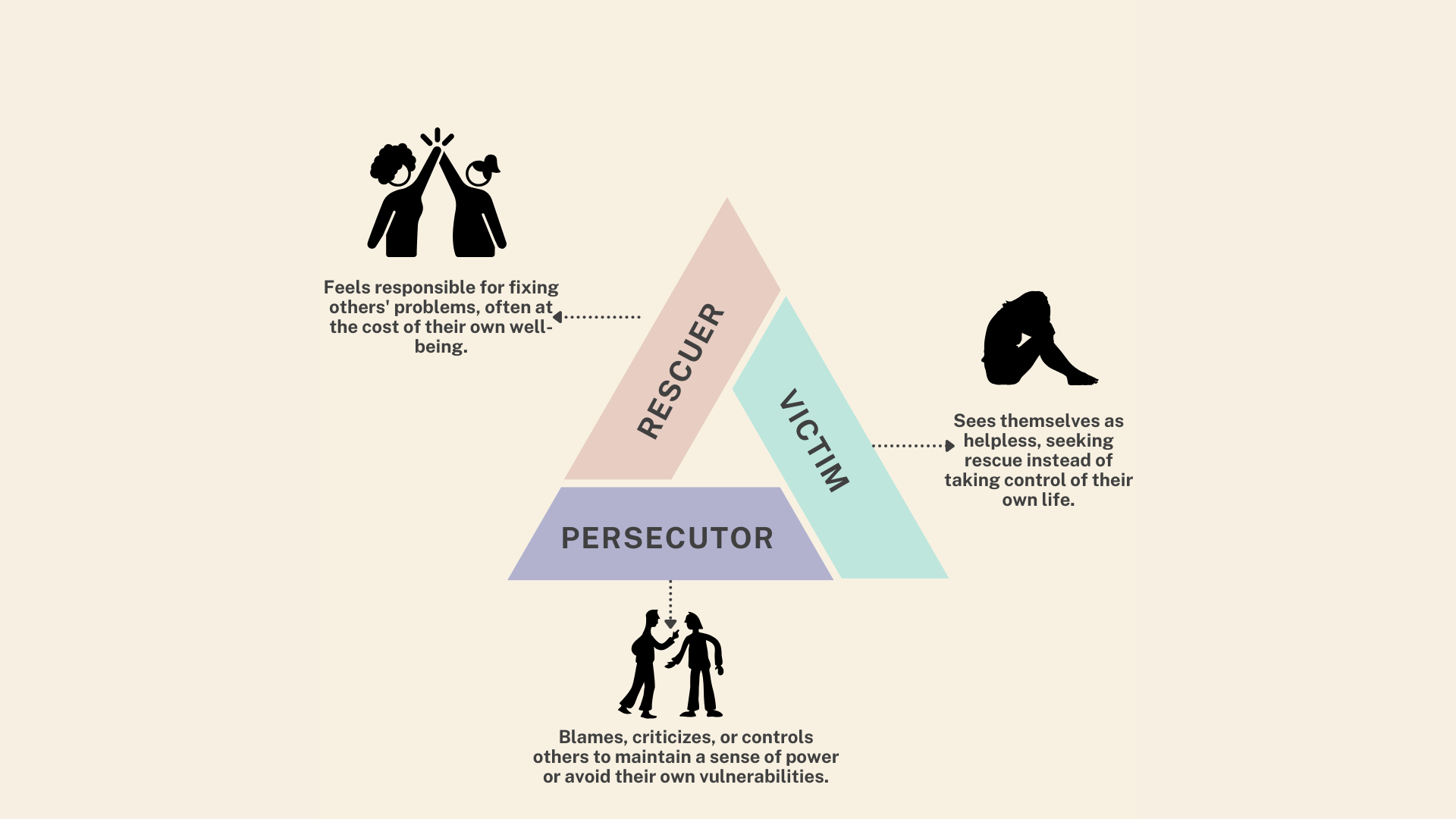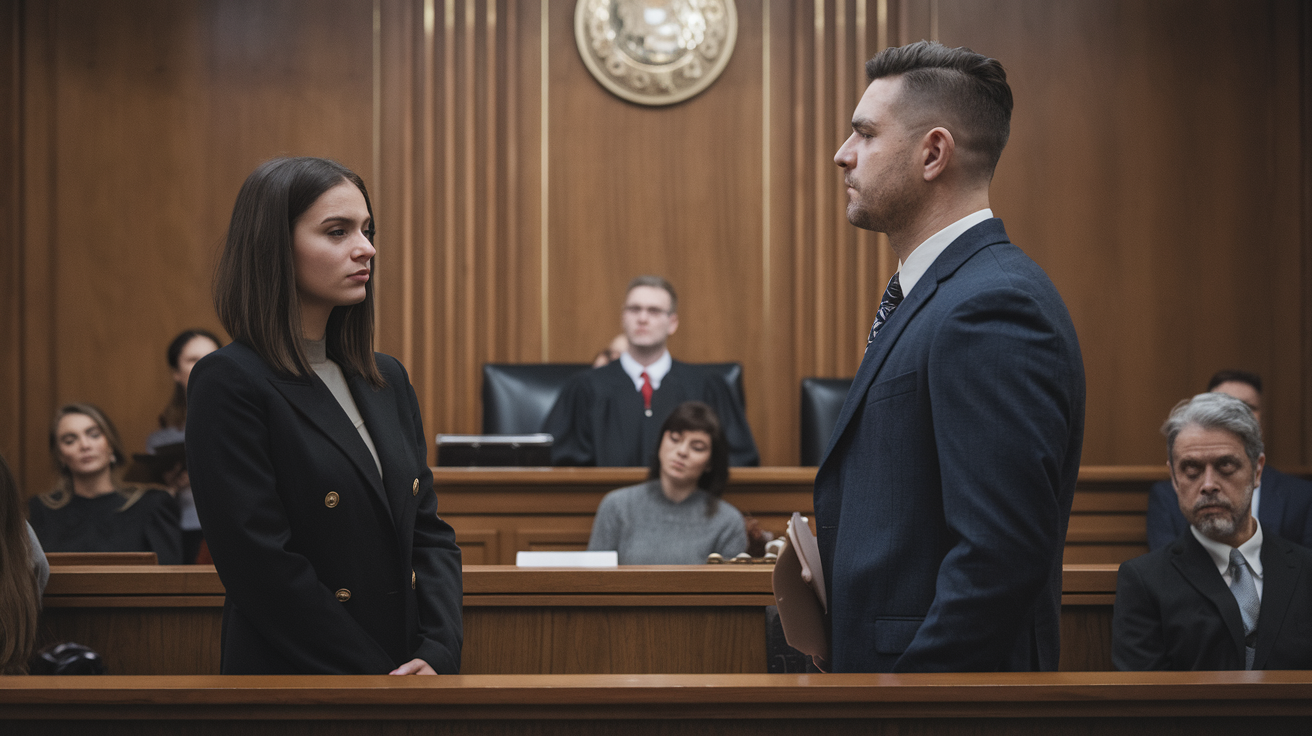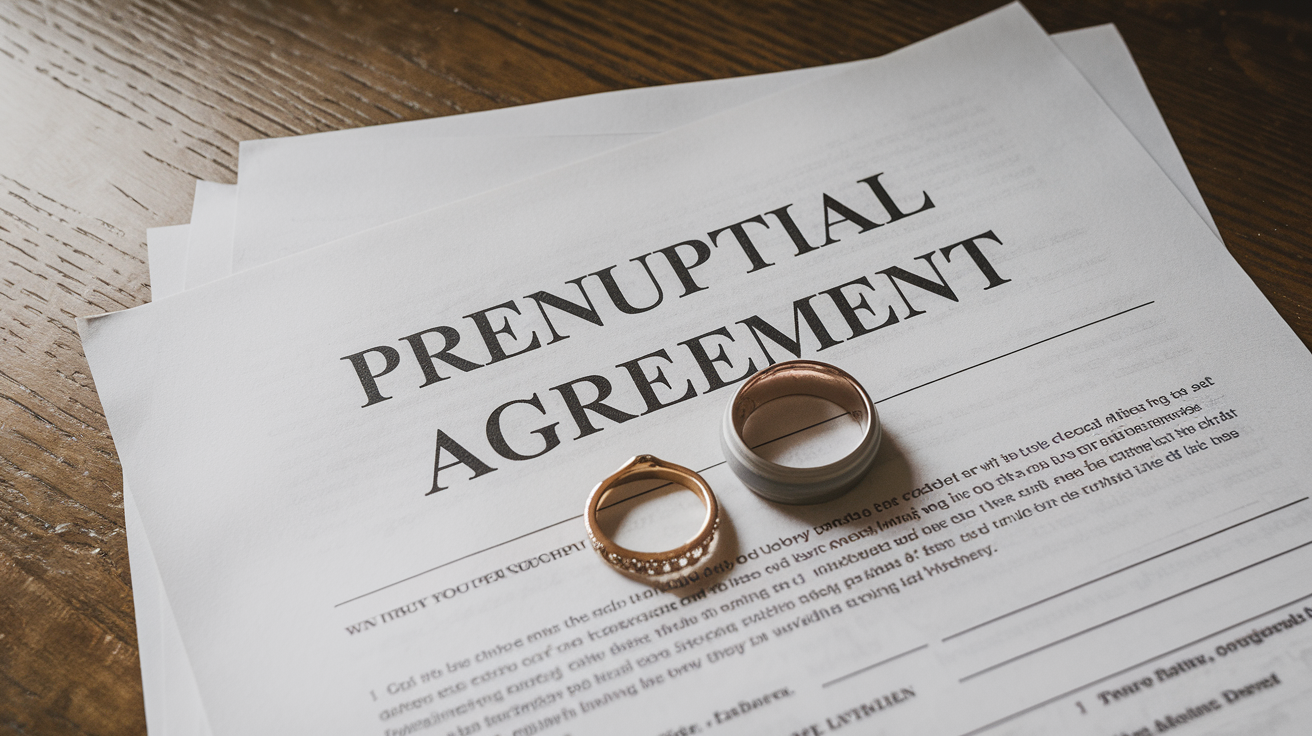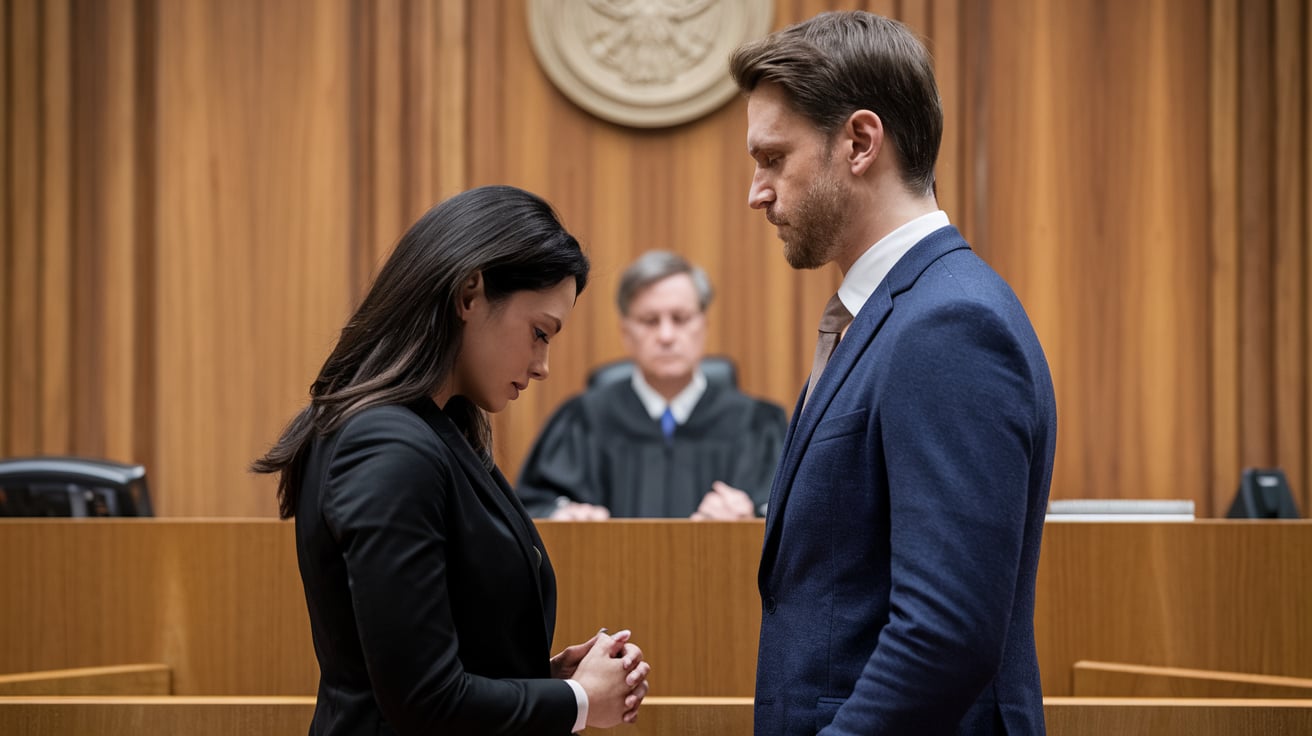Ever felt trapped in a relationship cycle that leaves you emotionally drained? The codependency triangle might be at play. This psychological pattern subtly shapes interactions, often without people realizing it.
It revolves around three roles—the Rescuer, the Victim, and the Persecutor—each feeding into a cycle of dependency, blame, and an emotional web. Think of it as a dance where each person plays a specific role.
Recognizing the roles at play helps in making conscious choices rather than reacting out of habit.
The good news? Change is possible.
By identifying unhealthy interactions and establishing boundaries, it becomes easier to step out of the cycle and foster healthier connections.
What is a Codependent Relationship
To understand what a codependent triangle is, we first have to get into what a codependent relationship is.
It forms when people connect in ways that aren’t healthy for either person. One person often puts their partner’s needs before their own, while the other becomes too dependent on that care and attention.
Let’s break it down with a simple example: Think of someone who always says “yes” to their friend’s requests, even when they’re tired or busy. They might skip their own plans, work extra hours, or spend money they don’t have – all to keep their friend happy. Meanwhile, their friend starts expecting this help and finds it hard to handle problems on their own.
The tricky part? Both people might think this setup works just fine.
But over time, it creates stress, builds resentment, and stops both people from growing. The helper feels drained, and the person getting help never learns to stand on their own feet.
Root Causes of a Codependent Relationship
- Childhood Conditioning – Growing up in a home where love was tied to pleasing others or meeting high expectations can create codependent tendencies.
- Emotional Neglect – When emotional needs are ignored or dismissed, people may learn to seek validation through caretaking and over-giving.
- Unhealthy Family Dynamics – Being raised in an environment with addiction, abuse, or controlling behaviors can lead to codependency as a coping mechanism.
- Fear of Abandonment – A deep fear of rejection or losing relationships can cause excessive people-pleasing and emotional dependence.
- Low Self-Esteem – Feeling unworthy or not good enough leads to relying on others for approval and identity.
- Lack of Boundaries – When personal space and emotional limits are never taught or respected, it becomes difficult to say no or prioritize personal well-being.
- Over-Responsibility – Being conditioned to take care of others from a young age creates a habit of fixing, rescuing, and absorbing others’ problems.
- Past Trauma – Experiences like betrayal, neglect, or emotional instability can push someone into codependent patterns as a way to seek safety and control.
- Guilt-Based Love – When love feels conditional, people may believe they must sacrifice their own needs to be accepted.
- Unresolved Emotional Wounds – Suppressed emotions and unhealed past pain can make someone overly reliant on external relationships for emotional stability.
Codependency Triangle or Karpman Triangle

The Karpman Drama Triangle, often linked to codependency, is a psychological model that explains toxic relationship dynamics. Developed by psychologist Stephen Karpman, it illustrates how people fall into unhealthy roles—the Rescuer, the Victim, and the Persecutor—and unconsciously repeat these patterns in their interactions.
The interesting part? People don’t stay in one role – they move between all three spots, making the situation more complex.
These roles create a pattern that keeps going round and round. One person might start as a helper but end up feeling like a victim later. Or someone who seems to need rescue today might try to fix others tomorrow. Let’s look at each role in detail:
1. The Rescuer
The rescuer steps in as the constant helper, but their assistance often goes beyond healthy limits. They feel good when solving other people’s problems and might get upset when others don’t take their advice. These folks stay busy fixing everything around them, but their own life often sits on the back burner.
Think of a parent who does all their adult child’s laundry, pays their bills, and handles their job applications. While this might seem kind, it actually prevents the child from learning important life skills.
Rescuers often feel tired, stressed, and taken for granted. Yet they keep helping because they tie their self-worth to being needed by others.
2. The Victim
The Victim sees themselves as powerless. These people struggle to believe in their abilities and often feel stuck in tough situations. They see themselves as powerless and believe bad luck follows them everywhere.
For example, someone in the victim role might always talk about how their boss picks on them, their friends let them down, or nothing works out as planned.
Instead of looking for solutions, they focus on why things won’t work. This mindset makes them depend heavily on rescuers while pushing away genuine help.
3. The Persecutor
The Persecutor is the one who blames, criticizes, or controls others. They point out flaws in others and often make strict rules. Behind their tough exterior, they usually feel vulnerable and afraid of showing weakness.
Consider a manager who constantly criticizes their team’s work, sets impossible deadlines, and never offers praise. They might think this pushes people to do better, but it actually creates fear and resentment.
Persecutors struggle with close relationships because they push people away with their harsh behavior. They are not always a villain—sometimes, they’re reacting out of their own pain and unhealed wounds.
How to Identify Codependency Triangle
Most people don’t realize they’re caught in a codependent relationship. These patterns often feel normal because they might remind us of how we grew up or what we’ve seen in other relationships.
What looks like caring, loyalty, or responsibility can actually be unhealthy emotional entanglement. It’s only when exhaustion, resentment, or frustration creeps in that the cycle becomes more visible.
Codependency isn’t always dramatic. It can be subtle, hidden in small daily interactions—apologizing too much, feeling guilty for setting boundaries, or always prioritizing someone else’s needs over your own.
People in these roles often feel stuck but can’t pinpoint why. They might wonder why their relationships leave them drained or why conflict keeps repeating. Recognizing the Rescuer-Victim-Persecutor dynamic is the first step.
Here are Some Signs to Look for
- You feel responsible for fixing others’ problems, even when they don’t ask.
- You struggle to say no, fearing rejection or guilt.
- Your self-worth is tied to how much you help others.
- You often feel unappreciated, yet continue giving.
- Conflict in relationships follows the same frustrating pattern.
- Someone in your life plays the “helpless” role, expecting you to step in.
- You feel manipulated, controlled, or blamed without reason.
Steps to Break Through a Codependent Triangle

Breaking free from the codependency triangle isn’t easy, but it is possible. It starts with awareness and then moves toward conscious action. Each step helps untangle emotional patterns and build healthier connections.
Step 1: Recognize the Pattern
The first step is seeing the triangle for what it is. Many people stay stuck because they mistake codependency for love, loyalty, or duty. It’s easy to believe that constantly helping someone, feeling guilty when they struggle, or absorbing blame is just part of a close relationship.
But when emotions feel draining instead of fulfilling, it’s a red flag. Start noticing when you slip into Rescuer, Victim, or Persecutor mode.
Look at your own behavior patterns with honest eyes. Do you rush to fix everyone’s problems? Maybe you feel stuck and helpless most of the time. Or do you find yourself being critical and controlling? Write down situations from the past week where you played any of these roles.
Step 2: Set and Reinforce Boundaries
Codependency thrives where boundaries don’t exist. If you always say yes—even when you’re exhausted—or feel guilty for putting yourself first, it’s time to set limits. Boundaries aren’t about shutting people out; they’re about self-respect.
Start small. If someone constantly offloads their problems onto you, kindly but firmly let them know you can’t always be their emotional lifeline. If a loved one expects you to rescue them, remind yourself: You are not responsible for fixing what isn’t yours to fix.
At first, setting boundaries might feel uncomfortable, especially if others resist. But standing firm is necessary. Healthy relationships respect mutual space, and real love doesn’t require self-sacrifice at every turn.
Step 3: Take Responsibility for Your Own Emotions
Breaking free from codependency means owning your emotions—without placing them in someone else’s hands. If your happiness depends on fixing, saving, or receiving validation from
Taking care of yourself isn’t selfish – it’s necessary. Think of it like putting on your own oxygen mask before helping others on a plane. Make a list of activities that help you feel calm and strong. Maybe it’s reading a book, taking walks, or spending time with supportive friends.
Set aside time each day just for you. Even 15 minutes of quiet time in the morning can make a big difference. When you feel better, you’re less likely to fall into unhealthy relationship patterns.
Step 4: Shift to Healthy Communication
Codependent dynamics often involve guilt, blame, or avoidance. To break free, communication needs to change. That means expressing thoughts honestly—without manipulation, passive-aggression, or self-sacrifice.
Instead of saying, “I have to do this, or they’ll be upset,” try, “I can’t take that on right now, but I care about you.” Instead of rescuing someone, ask, “How can you handle this?” to encourage self-sufficiency.
Healthy communication is clear, direct, and respectful. It prioritizes honesty over guilt and connection over control. When conversations become open and balanced, relationships shift from dependency to mutual support.
Step 5: Prioritize Self-Worth and Healing
Codependency often stems from deep-rooted fears—fear of rejection, fear of not being enough, or fear of losing connection. The final step is learning that your worth isn’t defined by what you do for others.
Healing takes time. It may involve therapy, self-reflection, or simply choosing daily to detach from unhealthy patterns. Replacing old habits with new, healthier ways of relating will feel uncomfortable at first, but it’s necessary for growth.
Start by asking, What do I need? Then, give yourself permission to meet that need. Build relationships that are equal, fulfilling, and based on genuine care—not obligation or guilt.
Conclusion
Breaking free from the codependency triangle starts with one simple but powerful step—awareness.
Remember those three roles—rescuer, victim, and persecutor? They’re like old habits that can be replaced with new and better ones.
The good news? This cycle isn’t permanent. With clear boundaries, healthy communication, and emotional self-sufficiency, it’s possible to create relationships based on genuine care rather than obligation or guilt.
Healing from codependency doesn’t mean abandoning loved ones—it means shifting interactions toward balance and mutual respect. The more self-worth is nurtured from within, the less external validation is needed.
Frequently Asked Question
What Kind of Partners Do Codependents Attract?
Codependents often attract emotionally unavailable, controlling, or needy partners who reinforce their caregiving role.
Is Codependency Like Narcissism?
While both involve unhealthy relationship patterns, codependency stems from self-sacrifice and seeking validation, whereas narcissism is driven by a need for control.
What is The Triangle Trick in a Relationship?
The Triangle Trick refers to the Karpman Drama Triangle, where people unconsciously switch between the roles of Rescuer, Victim, and Persecutor.








